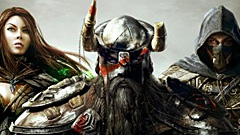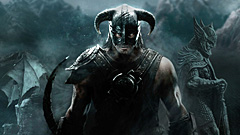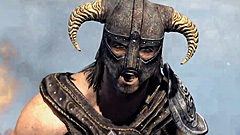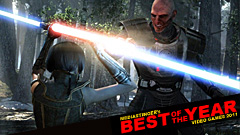December 27, 2011 by Paul Curtin


Starting off in a world of mystery, Skyrim places you in the back of a horse-drawn carriage, shackled and accompanied by some other very vocal prisoners. You’ll have no idea who you are or where you’re going, and you won’t even be able to move anything but your head from side to side in order to see who’s talking, but you’ll anxiously rubberneck back and forth as you try to figure out what exactly is going on and who’s saying what. Ironically, this is the first time you’ll enter Skyrim and the last time you’ll ever be locked down without the freedom to go where you want, when you want, throughout the entire game.
As you’re taken on this short introductory ride of Skyrim, you’ll reach a town full of citizens and discover their disdain for you and the rest of your newly found criminal brothers. When the ride finally ends, you’ll be able to get out and customize your character. Unlike other RPGs, there are no classes; instead there are ten playable races you can pick from, each possessing its own unique racial benefits. After you’ve spent a good 30 minutes in the character customization screen adjusting every little detail from skin color to facial structure and getting your character’s head exactly how you want it, you’ll come to discover that everyone captured is set to be executed via decapitation and it’s your turn in line at the chopping block. Luckily, all hell breaks loose as a dragon attacks the town and inadvertently saves your life by allowing you to escape amidst the chaos.
After the initial introduction to the world of Skryim the chains are literally taken off and you can choose to continue playing however you please. While you’ll be given a mission with a waypoint on the map, it’s your choice whether you want to go right away or run off into the woods to begin your hunt for Yetis (Snow Trolls), giants, or other mysterious creatures you might have already seen in previews. And that’s what makes Skyrim so great: the ability to go where you want, when you want, and with almost no limitations. Skyrim plays similarly to other open world games by Bethesda in the Elder Scrolls and Fallout series, but the world of Skyrim is bigger and better than anything Bethesda has ever done before.

Sure you can beat the game within 20 hours (as if that’s not already enough, being 2-3 times longer than most games out today), but with hundreds of dungeons, side-quests, crafting, and other random activities like stimulating or destroying the economy of a town, you can let your ADHD run rampant and have fun playing the game your way. And rushing through Skyrim isn’t something you’re going to want to do, as talking to everyone you come across, accepting every mission, and traveling to the edges of the map is the way the game is meant to be played to get the full experience. It’s easy to see how one could invest 100-300 hours in this game that never seems to end.
The sheer size of the world is truly amazing and a landmark in open world games. Bethesda has outdone themselves with the latest installment in the popular franchise and has created an entirely new engine, the “Creation Engine”, to run Skyrim. Just as in previous games in the series, Skyrim is a fully populated open world game filled with dynamic environments and dungeons you encounter never looking or feeling the same. Although it can sometimes be a little tiring trying to get to places across the map that you’ve not yet discovered, and the brilliantly scored majestic soundtrack mixed with the environmental sounds is so soothing and relaxing it can help put you to sleep, you can always buy horses at towns, and thankfully there’s the ability to fast travel from town to town once you discover them. If you’re looking for a game that you can just jump in and out of quickly, Skyrim might not be the game for you. Skryim is a game that demands time and patience; you can easily spend a solid 20 minutes running from one location to another.
To ease the pain of constantly running across the map to discover new locations, Bethesda has created a realistic living world and packed it full of random accuracies to make your journeys more enjoyable. You’ll find plenty of distractions like wild animals that attack on sight, random NPCs who will find you out in the middle of nowhere and ask you for your help or to hold something for them (starting a new quest), giants who have set up camp throughout the land and can kill you in one hit, massive prehistoric-looking animals like woolly mammoths and saber-toothed tigers, secret hideouts occupied by thieves, hundreds of hidden dungeons that can be discovered full of new enemies to fight and loot to collect, and best of all dragons that can randomly show up all while fighting any one of the enemies just listed.

Not only will dragons show up out of nowhere and try to kill you, but if you’re currently engaged in battle with anything else, the dragons will enter into an impromptu triple threat match with you and your foes. It’s awesome when you’re raiding a camp of thieves and suddenly hear the screech of a dragon and its wings flapping above you, causing everyone to shift their attention to fighting together and lighting the night sky up with fire and arrows in an effort to take down the beast. The process of taking a dragon out of flight and watching it crash into the ground, killing it, then absorbing its soul is the best use of dragons in any RPG to date.
While the world of Skyrim might be the main selling point of the game, there’s also a brand new spell system that allows players to dual-wield spells and use both hands to combine spells and make them even more powerful, similar to Street Fighter (HADOUKEN!) or Dragonball (KA..MEH..HA…). Players can also choose to hold spells in one hand and a weapon in the other, or hold weapons in both hands. Players can basically change their character’s class at any time by changing the type of weapons and powers they have equipped. There are also new Shouts which work like spells but can be used no matter what you’re holding in each hand and are inscribed on walls and hidden throughout Skyrim, which helps justify exploration if you want to be able to use skills like breathing fire, jumping ahead at super speed, or the ability to rend a dragon in mid-air and take them down for the kill.
The new interface for the talent upgrade system is also a thing of beauty with talent trees looking like constellations of stars having a vast amount of abilities to unlock; it’s little things like this that show how much detail is being put into the game to make it stand out from the rest, although I wish Bethesda made it a little easier to navigate as sometimes switching between skills horizontally can completely jump over the option you want. The method of selecting spells while fighting is also improved with the ability to quickly switch which spells you use in each hand on the fly.

Like previous RPGs from Bethesda, the more you use certain skills and items, the more that specific area of expertise will progress. Once reaching a certain skill level with a weapon, armor, or spell, you can purchase select skills from the tree – a method that works great and is sure to save you from wasting points on skills you don’t want. By putting points only into the skill trees you want like blocking, one and two-handed weapons, spells, speech, and more, you can build a character any way you want, and by allowing any character to use any skill/weapon, you can instantly change your “class” or combat style at any time to better take on the situation.
Sadly, Bethesda might have spent a little too much time upgrading their new spell system and while they’ve improved the melee combat with the addition of Fallout-style slow-motion killing blow animations, the combat still feels dated and empty. Swinging weapons at enemies doesn’t have a feedback where you actually feel like you’re making contact and can feel like you’re swinging at the air despite hitting the enemy. Slow-motion killing blows also work way better in Fallout and most of the time just make for awkward animations between characters who might not even come in to contact with one another like professional wrestling. Skyrim’s competition this year, Dark Souls, had a much better hit detection system that Bethesda should take some notes for their next title. Even outside of the combat system characters walk up stairs with their feet going through the actual stairs and don’t actually touch the doors and other objects they come in contact with, minor details that once again break the immersion you have with the game that feels so real.
Along with the character animations come bugs that plague what seems like every Bethesda game lately. In defense of Bethesda, when you make games as massive as Skyrim, it’s almost impossible to not have some bugs. But the bugs/glitches in Skyrim like characters glitching out through walls, long load times, framerate lag issues, console freezeups, and entire saved games becoming unplayable after a certain amount of time is unacceptable and borderline game-breaking. I played Skyrim on the PlayStation 3, which has been reported to have more problems than other formats, so I can’t vouch for other versions being better. But from what I’ve seen, Xbox 360 and PC owners might have a slightly better version, but they’re definitely not immune to a lot of the same problems.

Another big issue is the dialog between NPCs in the game. The voice acting is top-notch, but the way the game is programmed causes random characters to deliver the same exact lines. You can have a person walk up to you multiple times and say the same exact thing like how they used to be an adventurer until they took an arrow to the knee. What’s worse is how characters in different areas of the game will repeat the same lines as one another — how many people in Skyrim were adventures forced into early retirement due to arrows to the knee? Sure the repetitive voice acting is funny and has even become an internet meme, but it’s an area that Bethesda shouldn’t have slacked on.
There were also many times in smaller rooms containing a larger amount of people where I’d be talking to an NPC receiving important information and a couple random other NPCs right next to us would be talking so loud at the same time that I couldn’t make out what the quest giver was saying — I wanted to turn to my left and shut them up with the swing of my mace, but couldn’t because of how the game locks you into place while having conversations. Skyrim does use a slightly better conversation style than previous games in the series where the camera doesn’t always zoom in to a closeup of their face, but it still locks you into place without the ability to switch back and forth between first and third person view.
Even with all its problems, Skyrim manages to still live up to the hype and be a unique open world experience that you won’t find in a game that isn’t made by Bethesda or BioWare. The ending is a little bit anti-climatic and will have you asking “That’s it?”, but the truth is that after you beat Skyrim there’s almost no doubt that it isn’t it and you’ll still have another hundred hours of new areas to discover, dragons to kill, and dungeons to raid. With DLC planned for the future, Skyrim might be the biggest RPG ever made for consoles. If you’re into singleplayer RPGs, whether a fan of fantasy or sci-fi, Skyrim is a game you’ll want to check out. The Elder Scrolls V: Skyrim gets 4.5 out of 5 stars (Amazing).
The Pros
- A fully alive, massive open world unlike any other RPG
- Revamped melee/spell system makes combat more enjoyable
- Hundreds of hours’ worth of content
- Top-notch voice acting
- One of the best musical scores ever
The Cons
- Tons of bugs and glitches
- Melee still feels like you’re not connecting and just swiping at the air
- Character animations can at times be awkward
- NPCs will repeat the same lines over and over again














